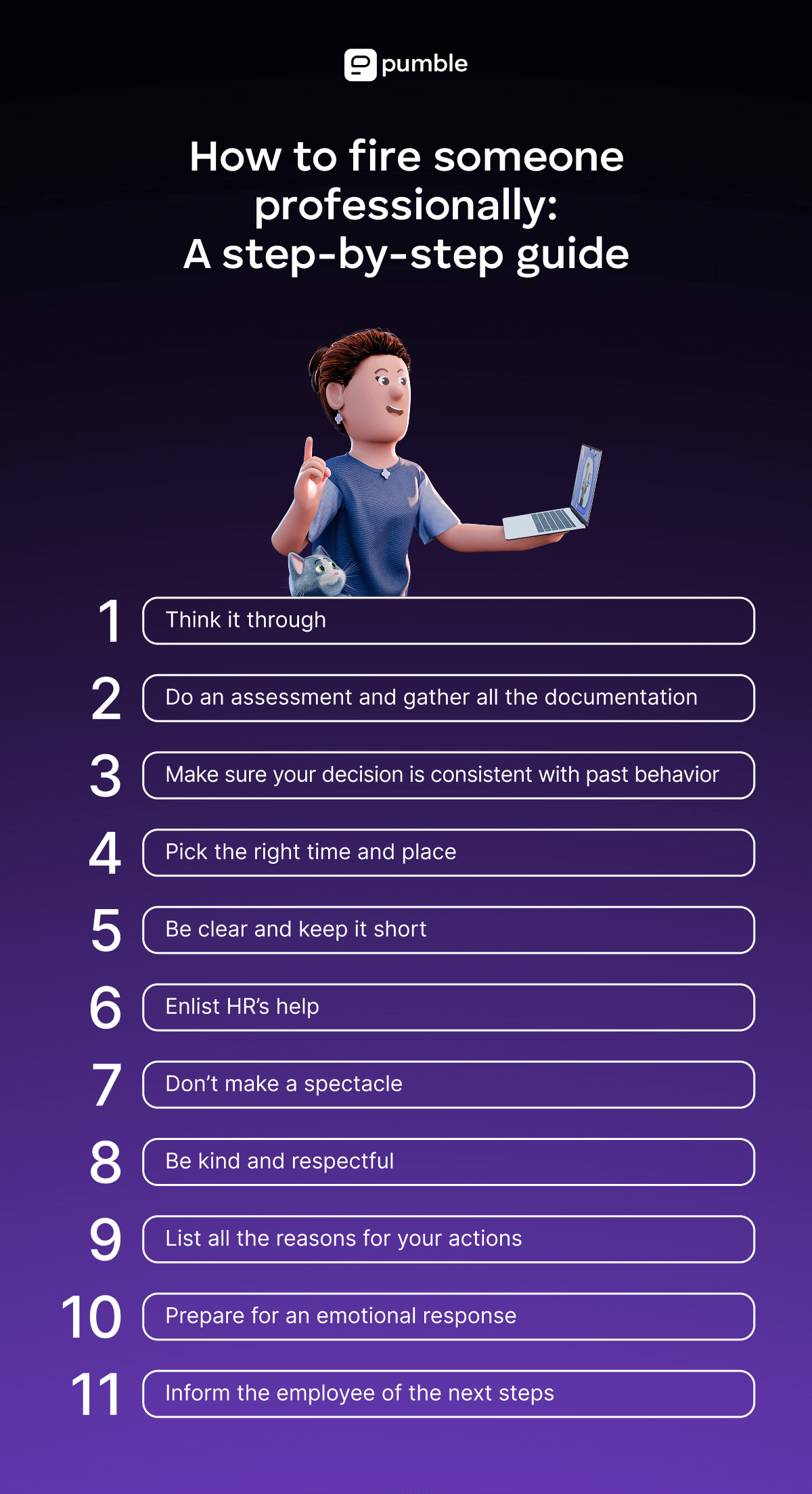Firing someone is one of the toughest parts of being a manager — and one of the most important to get right.
Done poorly — it can create confusion, damage your team’s morale, or even expose your company to legal risk.
Done well — it shows leadership, protects your culture, and sets clear expectations for performance and behavior.
This guide will walk you through everything you need to know about how to fire someone professionally.
Here’s what we’ll cover:
- What are the valid reasons to fire someone,
- What steps you need to take to fire someone,
- What to say (and not say) when firing an employee, and
- Sample termination scripts and what to say when letting someone go.
Let’s get into it.

Table of Contents
Valid reasons to fire an employee
Firing someone is a difficult decision — but sometimes, it’s the right one for the health of your team and business. Knowing the valid grounds for termination and how to fire an employee with professionalism and empathy is key.
Here are some of the common and valid reasons for termination:
- Discriminatory behavior — If an employee engages in discrimination based on race, gender, religion, age, or other protected traits, it undermines a safe work environment. Document all incidents before deciding to terminate an employee.
- Harassment, bullying, violence, or disregard for safety — These behaviors create a toxic workplace. This includes mental harassment, aggressive language, or ignoring safety protocols. In such cases, you may need to terminate an employee quickly and decisively to protect others.
- Unethical conduct — Lying, falsifying records, or hiding key information are serious violations. These performance issues can erode trust and justify termination.
- Poor job performance — Chronic lateness, sloppy work, or not meeting expectations after multiple performance reviews is a clear reason for dismissal.
- Lying on a resume — Discovering that someone misrepresented their skills or experience during hiring is a valid reason to let them go.
- Substance use during work hours — Being under the influence at work poses safety and liability risks. This often calls for immediate action.
- Misuse or damage of company property — Theft or intentional damage is not just a policy violation — it’s a breach of trust. Make sure the termination script clearly states the reason and references your company’s policies.
- Excessive absenteeism — Repeated no-shows, long unexplained absences, or chronic lateness despite warnings may justify dismissal. Before the termination meeting, ensure proper documentation and review of attendance history.
- Violation of company policies — If employees break communicated rules, especially those that impact operations or reputation, that’s grounds for termination. However, minor infractions may warrant coaching first.
- Insubordination — Refusal to follow reasonable, lawful instructions from supervisors disrupts workflow and respect. This is a valid reason to terminate an employee, especially if it’s ongoing or blatant.
- Inappropriate behavior outside of work — Some companies consider off-the-clock behavior that reflects poorly on the business as a firing offense, especially if it involves illegal or unethical acts.
- Poor cultural fit — If someone’s values, work style, or attitude clash with your company’s culture, affecting team dynamics, this may be a factor in the decision to terminate.
How to terminate an employee
Terminating an employee is arguably the toughest task a manager can have. Since 69% of managers are uncomfortable communicating with their employees in general, firing someone is probably at the top of their list of difficult conversations they don’t want to have.
However, it’s still an inevitable part of the job.
So, let’s look at all the steps you need to go through to fire someone professionally and make the process easier on them (and yourself).

Step #1: Think it through
The first step in firing someone is thinking about whether that is necessary or not. Firing an employee should never be one of the first measures you take — in most cases, it should be your last resort.
Unless the employee in question did something that requires immediate termination, you, as a manager, need to do everything you can to see whether they can improve.
For example, check whether the employee received enough support from you during their time with your team. Also, ask yourself the following:
- Did you communicate your expectations clearly?
- Were you assertive in your communication?
- Did you offer constructive criticism?
- Did you point out their mistakes and give your employees the opportunity to correct them?
- Did you offer your employees all the necessary resources for them to succeed?
All of these questions should be a vital part of your thinking process.
💡 Pumble Pro Tip
As a leader, your communication style can transform the way your team works together. To find out more about different types of leadership communication, check out the following posts:
Step #2: Do an assessment and gather all the documentation
After thinking your decision through, it’s time for an evaluation.
The termination shouldn’t come as a surprise to either the person you’re firing or the rest of your team. That means there should already be evidence of poor performance, excessive tardiness, or other valid reasons for the termination.
Professor and Chair of Organizational Leadership at Utah Valley University and member of the Forbes Coaches Council, Jonathan H. Westover, states that documenting everything should be your first step when it comes to firing someone.menting everything should be your first step when it comes to firing someone.

“The first step is to clearly document the reasons for the termination. This documentation should include any warnings or disciplinary actions that were given to the employee prior to termination. This documentation will be important in case of any legal issues that may arise.”
So, you’ll want to have all the necessary documentation and prepare what you want to say.
💡 Pumble Pro Tip
Doing an official assessment isn’t something that comes easily for managers. To get the best tips on how to do it properly, check out this Pumble blog:
Step #3: Make sure your decision is consistent with past behavior
One of the most important steps in firing an employee is making sure you’re going by the book. Unlawful terminations can cost your company a pretty penny, considering the potential for the employee to file an unlawful termination lawsuit.
To avoid that, you should ensure that you’re doing everything according to the law and your company’s rules.
Moreover, you also have to ensure that the decision to terminate an employee is consistent with your past behavior.
For example, you can’t fire Paul for being late 4 days in a row when you didn’t fire Mary for the same reason last month. Similarly, you also can’t fire Paul for being annoying or disruptive — his transgressions need to be bigger and, more importantly, against the company’s code of conduct (or the law).
So, keep your emotions out of it, and make decisions based on the rules at hand and previous behavior.
Step #4: Pick the right time and place
Once you’ve made the decision to fire someone, you might be eager to get it over with as soon as possible. However, patience is a virtue and, in this case, absolutely necessary.
You don’t want to fire your employee in the middle of the work day, in front of the entire office. That would cause unnecessary strife in your team, as people would deem it unnecessarily cruel (because it is). It would also damage your managerial reputation and your company’s reputation.
That’s why you have to think about the time and location of the event beforehand.
Find a private spot (like your office or a conference room) to have a professional conversation with the employee, and ensure your actions aren’t impacting the business procedures. When you start the meeting, ensure you’re positioned in a way that the employee’s back is turned toward the door — in case you’re interrupted, the employee won’t have to face the person who interrupted you, which will come in handy if they have an emotional reaction.
If you or your employee is working remotely, schedule a one-on-one private meeting to let them go. Make sure you’re in an empty conference room or office where no one will be able to eavesdrop on the sensitive conversation. Also, it may be a good idea to let your employee know beforehand what the meeting will be about, so that they too can be prepared for what’s going to happen. You can message them privately before the meeting or include the information in the meeting agenda.
Step #5: Be clear and keep it short
Once you have found the appropriate time and place, try not to dilly-dally. Your meeting with an employee to terminate them isn’t the right time for small talk.
Instead, be clear about what’s about to happen.
For example, you can use one of the following openings:
“Hello [Name], thank you for coming. I’m afraid this won’t be a pleasant talk, as I’ve got some bad news for you.”
“[Name], please take a seat. I’m afraid I have some bad news.”
By doing this, you’re setting the tone and the employee’s expectations, making them aware of what’s about to happen.
Aside from being clear, you also have to try to keep things short. Delivering a whole speech about what you’re about to do and making them sit through it is unnecessary (and also a bit cruel). Instead, say what you need to say and then pause to leave some room for them to react.
💡 Pumble Pro Tip
If you’re struggling with having difficult conversations at work, you aren’t the only one. For a few extra tips on how to conduct them, check out this Pumble blog post:
Step #6: Enlist HR’s help
As a leader, you have the full authority to fire an employee on your team. However, consulting with HR beforehand is a smart idea.
Firstly, they’ll let you know when an HR rep will be available to sit in with you at the meeting with the employee in question. Having someone from HR there as a witness and a potential mitigator is always a good idea.
But, more importantly, they can offer some information you might not have.
For example, they’ll be aware of all complaints filed by other employees against the person you’re considering terminating.
On the other hand, they might also be aware of other things that you should consider. The constantly-tardy-Paul from our previous example might have a wife who’s having a difficult pregnancy, which explains his constant tardiness. That doesn’t excuse him, but it is something that other teammates might also know. So, firing Paul for being tardy at that moment would paint you in an unnecessarily bad light.
The HR department will be your best ally during this daunting task, so don’t shut them out.
Step #7: Don’t make a spectacle
No matter the reason behind your decision to terminate an employee — be it one huge mistake or a string of small ones — you should never aim to “make an example” out of the firing. In other words, don’t turn this private situation into a spectacle. Allow the person you’re firing to leave with dignity.
If you don’t, and you end up making a spectacle out of it, you might find your team’s morale affected by that display of negative communication. That, in turn, can greatly affect their productivity and engagement.
If the employee in question made a mistake that you don’t want anyone on your team repeating, you can set a separate meeting with the entire team to explain the whys and hows of their mistake.
💡 Pumble Pro Tip
If you do end up scheduling a meeting to discuss the mistakes that got someone fired, make sure that the meeting is as effective as possible. To learn how to make your meetings more effective, read the following blog post:
Step #8: Be kind and respectful
When terminating an employee, you must communicate effectively. It’s also vital that you’re completely transparent in your delivery.
However, that doesn’t mean that you should be rude or blunt.
Try to be as compassionate as possible, but don’t make it about yourself. As difficult as this task must be for you, it’s undoubtedly harder for them.
So, avoid phrases like:
- “I know what you feel like” — even if you do, how is that helpful at the moment?
- “This is one of the hardest things I had to do in this position.” — we’re sure that’s true, but to someone who’s being fired, it means very little.
- “This is harder for me than it is for you.” — it really isn’t.
Step #9: List all the reasons for your actions
If you’ve prepared all the documentation as we suggested in step #2, this won’t be an issue.
However, just having the documentation isn’t enough.You must also present the information you have to the employee. Be clear and unwavering, and explain why you decided to terminate them.
Don’t use ambiguous language. It might be tempting — ambiguous language is often overused in business communication — but avoid it at any cost, as it might give the employee the wrong impression or even create false hope. Make sure you actually say the words “We’re terminating you” or “We’re letting you go.”
Step #10: Prepare for an emotional response
Since firing someone is never pleasant for any party, you need to prepare yourself for an emotional response.
No matter how expected the termination is, the employee you’re firing will probably have something to say about it, and they might get confrontational, argumentative, angry, or even violent.
When you properly prepare yourself for an emotional outburst from the other party, you’ll be less likely to fall into a trap and respond emotionally.
As a leader, you need to be level-headed and not get into arguments with the employee in question. Even if they are argumentative or hostile, listen to them respectfully and answer their questions, but don’t get into a debate.
Step #11: Inform the employee of the next steps
Finally, once the difficult conversation is coming to an end, you need to make sure you inform the employee of the next steps.
If you have an HR rep with you, they’ll probably assist you with that and give you the necessary information about payroll, residual benefits, and administration. If not, make sure to have a plan about what you’ll say.
What to say and do when firing an employee
When you’re firing an employee, how you conduct the conversation matters just as much as the decision itself.
Here’s how to handle it with clarity, respect, and control:
- Do it face to face. Firing someone in person (or via video call for remote teams) is the most respectful approach. Firing someone over the phone or, worse, over text should only happen in extreme situations.
- Be clear and direct. Avoid vague language. Use present tense to emphasize that the decision to terminate is final. Instead of “We’re going to let you go,” say, “You’re being let go.” This helps avoid confusion and is key when preparing a script for terminating an employee.
- Set aside enough time. Don’t rush the meeting. Blocking time for this difficult conversation ensures you can handle questions or emotions properly and shows respect for the individual being let go.
- Provide specific feedback. Vague reasons don’t help. Be honest and factual, especially when addressing performance issues. This is crucial if you’re looking for what to say when terminating an employee for poor performance or drafting a termination script that avoids legal risk.
- Show compassion. If you’re searching for a how-to-fire-someone-nicely example, it starts with empathy. You can offer a reference letter or support, but avoid false promises. Stay human without creating false hope.
- Actively listen. Even if the termination script is prepared, leave room for the employee to speak. Their input can offer insight for future performance reviews or prevent similar issues with others.
💡 Pumble Pro Tip
If you’re not sure what separates active listening from listening in general, check out the Pumble Learn article below to get the best tips:
What NOT to say and do when firing an employee
Firing someone is a difficult conversation that requires care and professionalism. Here’s a quick list of common mistakes to avoid — and why they matter:
- Don’t do it on a whim. Termination should be a deliberate, documented decision, not a reaction to frustration or anger.
- Don’t harass or humiliate the employee. Stay professional, no matter how tense the situation gets. Dignity and respect matter, even in tough moments.
- Don’t give false hope. Avoid vague language or sugarcoating. Be clear about the decision to prevent confusion about possible second chances.
- Don’t fire someone without a witness. Always have an HR rep or neutral party present to document what happens during the termination meeting.
- Don’t give a long speech. Keep it short and clear. Over-explaining can lead to confusion or make you sound unsure of your decision.
- Don’t do it in front of others. Terminating someone publicly is unprofessional and damaging to team morale. Always have this difficult conversation in private.
Scripts for how to fire someone
Still unsure how to fire someone professionally, even with a step-by-step guide? You’re not alone — many managers struggle with what to say during a termination meeting.
Below are ready-to-use termination script examples for different situations to help you handle the conversation with clarity, confidence, and compassion.
General script for how to fire someone
If you want to stick to the basics, you can always follow a general script for firing someone and adapt it to your needs.
Here’s one example of a short termination script:
“[Name], thank you for coming to this meeting. I’m afraid I don’t have good news. As you know, we’ve had several conversations in the past about [an issue/issues the employee had]. Even with guidance from me and the rest of the team, you aren’t showing enough signs of improvement. That’s why we are letting you go. Today will be your last day here.”
Another example of a general script would look something like this:
“Hello, [Name]. During the previous [time period], we have done several assessments of your work during our performance reviews because you consistently weren’t able to meet [business targets]. Each assessment included detailed feedback and remarks on what you could improve. Since you weren’t able to progress as quickly as we needed you to, we have decided to let you go. Please leave your key fob, badge, and all equipment on your desk by the end of the work day.”
Script for how to fire someone for poor performance
Although general scripts would work well when looking for a professional way to fire someone for poor performance, it’s not a bad idea to be more specific in those instances.
Offer more examples of performance issues as well as documentation that illustrates what you’re talking about.
So, if you’re firing an employee for poor performance, you might want to say something like this:
“[Name], I’ve called this meeting with you to let you know that we’ll, unfortunately, have to let you go from the company. We’ve raised several issues with you regarding your performance. You may remember the evaluations we did on [date and time] and [date and time]. Unfortunately, the results of our assessments showed that, although you’re a diligent worker, you simply aren’t able to meet our [daily/weekly/monthly goals].
Your poor performance affects the entire team because other people have to work harder to ensure the team meets the overall quota.
Due to that, we have decided that today will be your last day in the company. Your final paycheck will be deposited in your account within [time period]. You’ll also receive an outline of the reasons for your termination from [HR rep’s name].
I’d like you to know that even though things didn’t work out the way we hoped, working with you has been a pleasure. You’re a hard worker, and I’m sure you will have a lot of success as a member of some other team.”
This script strikes a balance between professionalism and compassion — exactly how to fire someone nicely without sugarcoating.
Script for how to fire someone who is not a good fit
Firing someone because they aren’t a good culture fit is a bit of a tricky task. It’s tough to do it without basically saying, “Your personality sucks.”
That’s why you must pick your words carefully here.
Here’s what to say when firing an employee who simply doesn’t mesh with the team:
“[Name], I wanted to talk to you about your role in the team.
Sadly, I think that your time with us has come to an end. Over the past few months, I’ve noticed that your communication with your teammates has been distant and sometimes even hostile. You often work on your own instead of reaching out to others and even look down on your teammates when they seek help.
As a manager who nurtures a collaborative environment, I came to the conclusion that you simply aren’t a good fit for this team. Your work has been solid, and I had very few complaints about its quality. However, fit-wise, I feel like you’d be much happier in some other team that works a bit differently than we do.
I’d be happy to write you a recommendation letter if you need one, since I believe your skills will be invaluable to someone else.”
This is a respectful, honest way to handle a difficult conversation while protecting your team’s cohesion and morale.
Bonus: Remote termination script
If you must handle a termination remotely, here’s a quick firing-someone-over-the-phone script:
“[Name], I wanted to speak with you today about your position. I know this isn’t ideal over the phone, but due to [circumstance], we had to proceed this way. We’ve reviewed your performance and past discussions, and unfortunately, we’re ending your employment effective immediately. HR will send you all follow-up documentation shortly.”
Avoid firing someone over text unless there’s absolutely no alternative, and always follow up with formal documentation.
Keep things polite and professional with Pumble
Even when justified, firing an employee who worked for you (maybe even for years) is tough. It’s also a process that takes quite a bit of planning.
But, with some preparation and by following our 11-step guide on terminating an employee, we’re sure you’ll make it through.
To ensure the entire process goes as smoothly as possible, try scheduling a 1-on-1 meeting with your employee over Pumble.

With Pumble, a team communication app, you’re also able to:
- Send direct messages,
- Communicate with team members in group chats and dedicated channels,
- Schedule voice calls, and
- Schedule video conferences.




